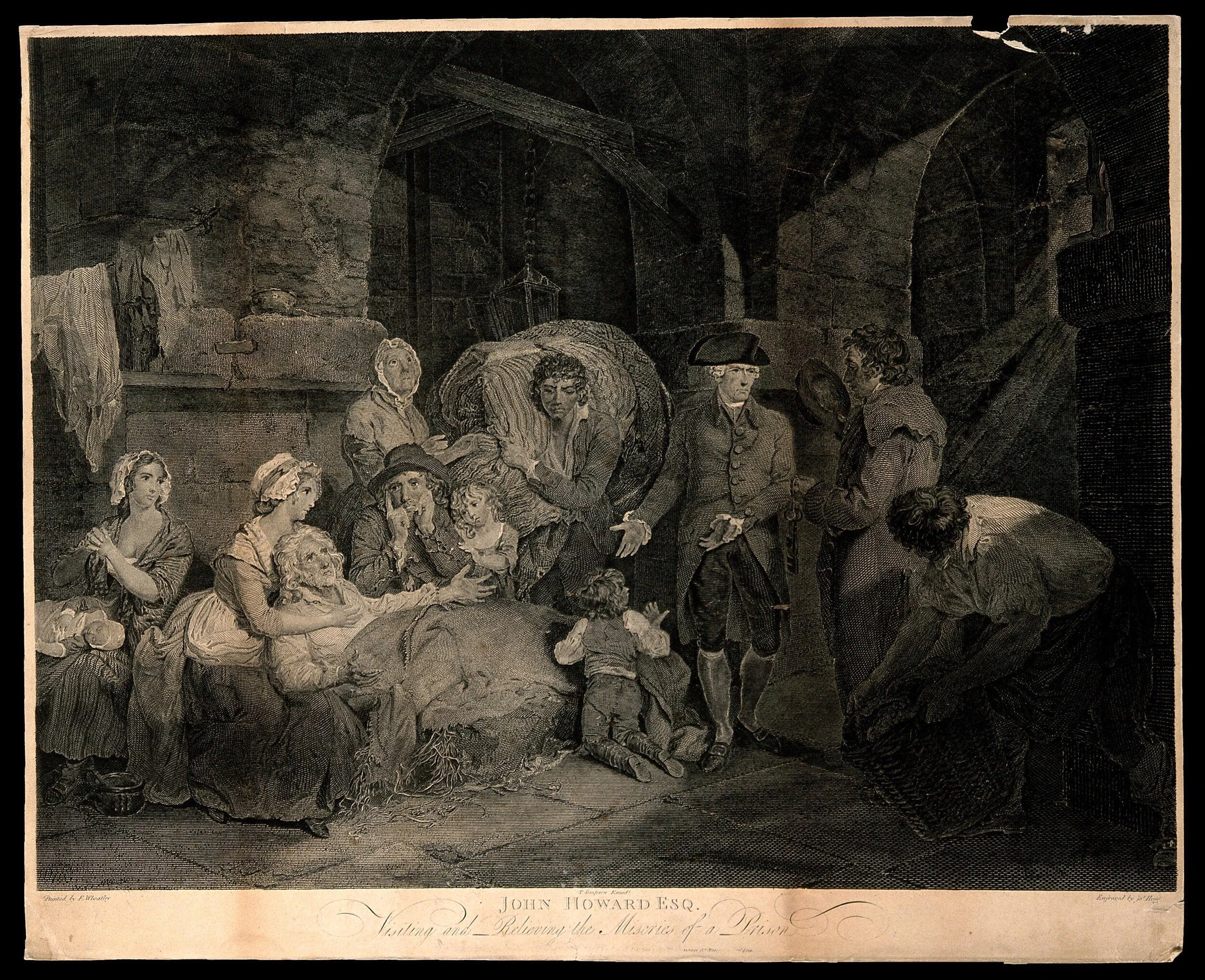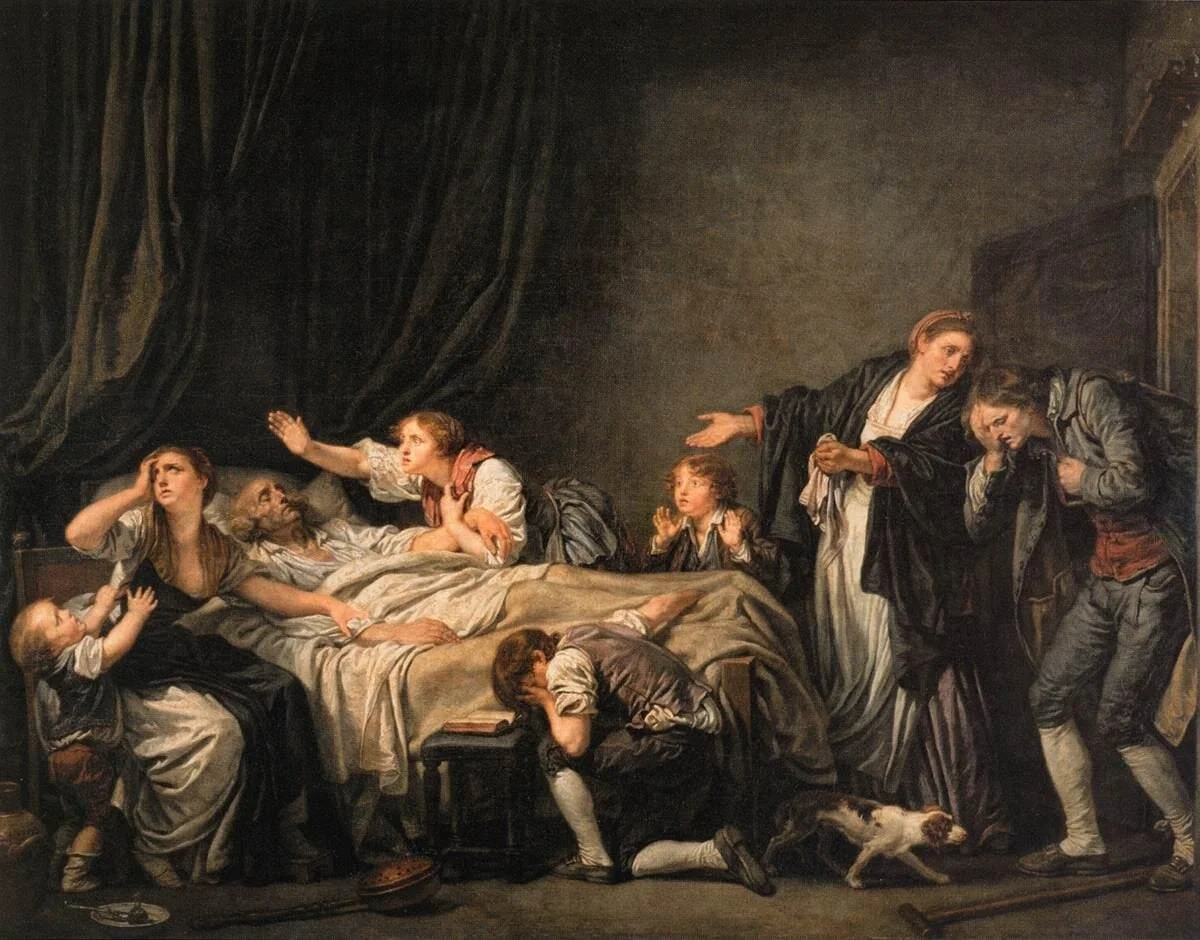Complaining about Incarceration
Fig. 1. Charles Samuel Keene, Pity the Poor Prisoners!, published in Punch November 21, 1868.
When Austin Reed recalled his time in New York’s notorious Auburn Prison in the 1840s, he punctuated his harrowing memoir with a scene of appeal. The keeper has marked him for punishment, and the warden approaches with a heavy cane in hand. Reed speculates about what sort of torture he’ll be subjected to, before resolving that “by the infernal G—, he shan’t throw a drop of water on my head till he hears my complaint. He’s just as much a right to hear my complaint as he has the Keeper’s, and he has got to do it, too, before he punish [sic] me.” Reed describes the sort of encounter that routinely takes place in prison today: a guard decides that someone needs disciplining and the ostensible offender claims redress from a higher authority. Other formerly incarcerated writers, such as Albert Woodfox, have vividly chronicled a war waged through punishment on one hand and complaint on the other. In Reed’s case, the keeper’s side wins out.
The large corpus of prison literature produced before the modern rise of mass incarceration is full of complaint, but nothing looks quite like Reed’s challenge to the warden. Boethius’s influential Consolatio philosophiae, composed during the author’s captivity in the sixth century, set a template that many medieval and early modern writers followed. An early stanza in James I of Scotland’s famous prison poem, The Kingis Quair, distills the formula: the author describes his “prosperitee,” shows how it lays the ground for the “infelicitee” of confinement, then argues that philosophy affords prisoners the ultimate comfort. His schema implicitly naturalizes prison. Even when they figure as real, material places—as when Florentine poet Burchiello laments, “I have no water except for the roof drops, / Nor the sun if it is not checkered”—prisons appear as a given. Writers hope to get out of them, not to transform or eliminate them. Try as I might, I’ve yet to find medieval writers who share Reed’s conviction that he is entitled to complain, within his rights to name and dispute the particular injustices that govern the conditions of his incarceration.
Reed represents the rise of a specific trope: the complaining prisoner. Isomorphic with the seismic change in the penal landscape wrought by prisons, houses of reform, and workhouses during the eighteenth century, this figure appeared amidst resistance and ridicule. The notion that the very people suffering most from mass incarceration could testify truthfully about the system’s horrors was, and still often is, contentious. Complaining is easy to dismiss. After all, the warden treats Reed’s testimony as a preliminary to a punishment he almost certainly would have imposed anyway. Even more controversial is the idea that incarcerated people can critically analyze their position as well as simply report abuse. This is partly because complaints tend not to be framed in the language of rational argument that we’ve come to prize, instead taking vernacular forms that implicitly recognize, as Dylan Rodríguez puts it in a penetrating study of radical thought in prison since the 1970s, the “utter impossibility of dialogue and communication with the force—discursive, embodied, institutionalized—of one’s own domination.”
A cartoon titled “Pity the Poor Prisoners!”, which was published in the November 21, 1868 issue of Punch, explores some of the tensions produced by the specter of complaint in the mid-nineteenth century (fig. 1). Based on a sketch by the English humorist Charles Samuel Keene, the cartoon shows two groups confronting each other in prison. On the right, incarcerated men are arrayed around a single delegated speaker, one hand raised to his chin, the other cast aside in a declamatory gesture. They’re opposed by a group of well-dressed visitors. In the background (but the composition’s center), a constable and jailer with dangling handcuffs keep the clusters separate. The picture neatly diagrams carceral space; bars loom behind the men on the right, while a warden’s board loudly proclaiming “RULES” floats between the genteel observers. Keene’s signature at lower left implicitly associates the artist’s presence with the outside visitors, and the viewer is similarly placed among their ranks. (Interestingly, the signature has moved from one group to another in the reversal process that turned sketch into print.) We’re put in the position of spectator as the prisoner speaks.
The caption identifies the scene as visiting justices inspecting a county prison. One asks: “any complaints?” The prisoner’s reply explains the hand raised to his face, as he protests that the prison provides but a single communal bucket for shaving. His complaint strikes at the heart of Victorian anxieties about hygiene, indeed, at the changes reformers tried to introduce in the wake of activist John Howard’s famous campaign to show that English prisons were “constant seats of disease and sources of infection.” Keene rarely made up his own captions, sometimes devising them to fit suggestions made by friends and colleagues, sometimes letting wits add text later. It is unclear which was the case here, but the picture squares with Punch’s generally progressive stance on prisons. In the very first issue (July 17, 1841), Mark Lemon editorialized: “There is one portion of Punch’s drama we wish was omitted, for it always saddens us—we allude to the prison scene. . . . We are advocates for the correction of offenders; but how many generous and kindly beings are there pining within the walls of a prison whose only crimes are poverty and misfortune!” Picturing prison, Lemon suggests, will be a regrettable but necessary contribution to social criticism. Neither he nor Keene look much like abolitionists, but “Pity the Poor Prisoners!” shows how the magazine tried to keep both carceral conditions and the means by which they were critiqued in the public eye.
Fig. 2. Charles Samuel Keene, undated sketch, pen and brown ink on tan laid paper, 11.8 x 18 cm. Chicago, Art Institute of Chicago, The Charles Deering Collection 1927.6110.
Later reformers like Lewis Hine and Jacob Riis tried to use the camera’s documentary rhetoric to bring about social change. Even before Keene’s cartoon, Punch’s co-founder Henry Mayhew produced a magisterial survey of London’s prisons with John Binny in 1862, proudly advertising that its illustrations were engravings made from Herbert Watkins’ photographs. But in the 1860s, Keene’s reputation as a sharp-eyed observer of everyday London life was just as important an authentication. He obtusely insisted that he drew things just as he saw them, earning praise for his observational skills rather than the humor prized in his other Punch colleagues. The print retains some of the original drawing’s (fig. 2) rapid strokes, suggesting the work of a hurried eyewitness, even as it fills in details and blocks out passages with thick cross-hatching. “Pity the Poor Prisoners!” would not have read as reportage, but it would have looked like a plausible scene grounded in something Keene saw.
Fig. 3. John Hogg (after Francis Wheatley), John Howard Visiting a Prison, etching, 1790. London, Wellcome Library no. 544703i
Significantly, Keene’s composition breaks with earlier conventions of prison critique, which focus on the passive suffering of prisoners, by representing how the prisoners themselves make the complaint. In 1787, Francis Wheatley painted Howard visiting a squalid prison. Widely distributed in an etching by John Hogg (fig. 3), it shows a square-jawed Howard facing a jailer, keys in hand, gesturing to a tableau of suffering prisoners modeled after Jean-Baptiste Greuze’s popular paintings of bourgeois morality (fig. 4). A ray of light breaks in from the upper right, helping Howard illuminate the pathetic scene for the jailer’s—and viewer’s—edification. The incarcerated figures do not speak; Howard heroically mediates their plight, performing in the picture the work of showing, translating, and speaking for others that his books and philanthropy did in the world. As Angela Davis remarks, his efforts laid the ground for a modern prison system predicated on the excessive regulation of prisoners seen most clearly in the stripping of their sociability and their capacities to speak with each other or the “free” public.
Fig. 4. Jean-Baptiste Greuze, The Father’s Curse: The Punished Son, ca. 1777-78, oil on canvas, 130 x 163 cm. Louvre
In a recent discussion of covert filmmaking at Northern State Prison in New Jersey, Nicole Fleetwood describes how incarcerated people deploy cameras when the administrative system designed to respond to their complaints turns out not simply to fail but facilitate ongoing violence against them. Clandestine films made by Omar Broadway and Buddy Randolph record beatings, fights, and the suffocating conditions of the Security Threat Group Management Unit. They make art out of privation; they deliver an alternative form of complaint. Tracking the figure of the complaining prisoner within an abolitionist framework means noting its occlusion at the outset, exploring its ambivalent presentation as mass incarceration took hold, and amplifying the work of incarcerated artists and thinkers forced by circumstance to complain in formally innovative ways. I teach and organize with the Prison + Neighborhood Arts/Education Project in Chicago, a collective of artists and educators who extend the work of Margaret Burroughs at Stateville Correctional Center and beyond. We ground our practice in a commitment to facilitating and supporting knowledge production in prison, rather than simply delivering educational content from the outside, most notably through a think tank of scholars at Stateville and by supporting incarcerated-led efforts like Parole Illinois. We don’t want to be Wheatley’s John Howard.
Luke A. Fidler is a PhD Candidate in the Department of Art History at the University of Chicago and is currently Paul Mellon Fellow at the Center for Advanced Study in the Visual Arts at the National Gallery of Art.



